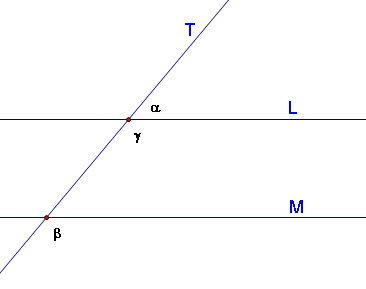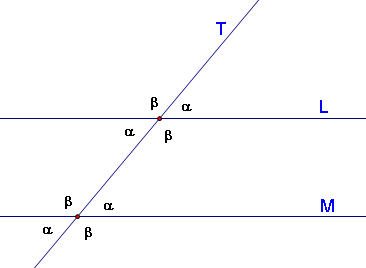
Proof of Corresponding Angles
by Floyd Rinehart, University of Georgia
and Michelle Corey, Kristina Dunbar, Russell Kennedy, UGA
Corresponding Angles:
Suppose that L, M and T are distinct lines. Then L and M are parallel if and only if corresponding angles of the intersection of L and T, and M and T are equal.
Proof:

=> Assume L and M are parallel, prove corresponding angles are equal.
Assuming L||M, let's label a pair of corresponding angles α and β. We know that angle γ is supplementary to angle α from the straight angle theorem (because T is a line, and any point on T can be considered a straight angle between two points on either side of the point in question). Note that β and γ are also supplementary, since they form interior angles of parallel lines on the same side of the transversal T (from Same Side Interior Angles Theorem).
Therefore, since γ = 180 - α = 180 - β, we know that α = β. This can be proven for every pair of corresponding angles in the same way as outlined above.

<= Assume corresponding angles are equal and prove L and M are parallel.
Assuming corresponding angles, let's label each angle α and β appropriately. By the straight angle theorem, we can label every corresponding angle either α or β.
For example, we know α + β = 180º on the right side of the intersection of L and T, since it forms a straight angle on T. Consequently, we can label the angles on the left side of the intersection of L and T α or β since they form straight angles on L.
Since, as we have stated before, α + β = 180º, we know that the interior angles on either side of T add up to 180º. By the same side interior angles theorem, this makes L || M.
|| Parallels Main Page || Kristina Dunbar's Main Page || Dr. McCrory's Geometry Page ||